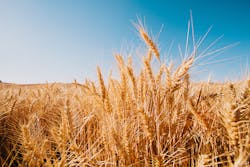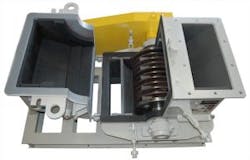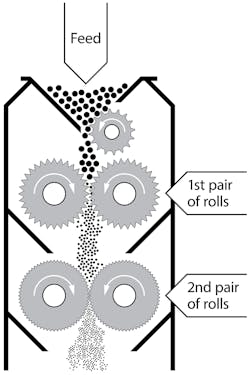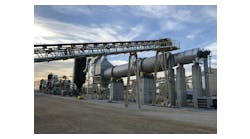Archeologists and historians have debated the early origins of alcoholic beverages with evidence of wine grapes dating back 10,000 years. Some believe wine came first, eventually followed by an accidental mash up of grain and water that yielded beer, but distilled spirits are definitely in the mix — and the milling. The Old Bushmills Distillery in Northern Ireland is the oldest licensed whiskey distillery in the world, with its license issued in 1608.
So what has changed with whiskey distilling over time? In a word — efficiency. The steps to convert raw grains into the myriad of beverages millions enjoy today remain largely the same. However, the processes have been refined or streamlined and are now considerably more efficient.
Starting with grains
Let’s take stock of the steps to produce whiskeys beginning with milling. Distillery milling breaks up cereal grains so that water can penetrate and facilitate the cooking process. Grinding increases a grain’s surface area. More surface area gives water and enzymes a better opportunity to penetrate the grain. A particle 1 inch in diameter has a total surface area of 3.14 square inches. If you divide that particle into 1,000 particles, surface area becomes 31 square inches.
The optimal size of the ground material varies according to the master distiller. Some think particles should be fine to allow maximum access for hydrolysis of starch, while others propose that larger particles provide better yield. Regardless of size, the idea is to expose the starch to water in a way that won’t cause handling problems. If the mash is too hard to de-water, then the distiller may lose liquid containing alcohol, decreasing yield.
Particle size distribution analysis of the meal should be performed on a regular basis. When the distribution falls outside specifications, the mill should be adjusted.
A hammer mill operation is based on the principle that more hammers, faster speeds and finer screens produce a finer grind. Graphic courtesy of Stedman Machinery Co.
Machinery types
Grinding corn, rye and malted barley in distilled liquor production calls for equipment performance typically required in food plants. The grain must not be overheated in the grinding process because it could affect the flavor of the final product, and the ground grain must be uniform, relatively coarse, and contain as little flour, or dust, as possible to prevent handling and dewatering problems.
Generally, a hammer mill is used for corn, wheat and rye; a roller mill for malted barley; and a cage mill for all four.
Hammer mills
Hammer mills use rectangular pieces of hardened steel attached to a shaft rotating at high speed inside the milling chamber. The hammers accelerate the grain into breaker plates lining the housing of the mill. Next, the grain encounters a changeable screen with a "close tolerance" gap between it and the rotating hammers.
Unique to hammer mill grinding is that material must pass through the screen to exit the mill. This guarantees the final product maximum size. Hammer configuration, rotation speed and screen sizes can be varied to process different grains, and each component can be changed individually. More hammers, faster speeds and finer screens produce a finer grind.
Hammer mills eliminate the need to screen product. However, when you fine-grind with a hammer mill, it may take more power per ton, and maintenance costs may be higher compared to roller mills. Master distillers should also consider that they could overgrind or create too many fines.
Roller mills cost more than some other mills but use less horsepower per ton. Graphic courtesy of Stedman Machinery Co.
Roller mills
Roller mills use compression to reduce the size of the grain as it passes between stacked pairs of rollers. The smooth rolls may turn at different speeds to introduce shearing forces, and the addition of grooved rolls adds tearing and grinding to the milling actions. Their slow speed doesn’t cause grain to heat or lead to related moisture loss.
Roller mills produce only small amounts of fine materials, keeping dust down. The shape of the particle at the end is irregular, cubical and spherical so the grain doesn’t tend to pack or become a solid mass. Bulk density is about 10 percent less than grain milled by a hammer mill, as the ground material is coarser.
Roller mills have a larger capital cost but use less horsepower per ton, and they may require screening to get a specific grain size distribution. Because it is an abrasive grain, corn may wear out a roller mill.
Cage mills
A cage mill consists of one or more rotating cages enclosed in a steel housing. Material to be ground is fed into the center of the revolving inner cage and passes outward through centrifugal force from row to row, before finally discharging through the bottom of the mill.
The source of size reduction in a cage mill is the result of impaction between the material being fed and the pins of the revolving cages. Impact-type grinding in the mill does not cause excessive heat and produces a uniform grind with minimum flour. Cage mills are used for larger production batches or continuous operations for corn, wheat rye, malted barley and other grains.
Properly setting the speed of the cages allows the succeeding rows to act on the particles that have not yet been reduced to the desired size, moving from the innermost rows outward. Particles that have been crushed sufficiently tend to pass through the subsequent rows without being materially affected, so adjusting the speed of the cages controls over-crushing and under-crushing.
Cage mill quality of production doesn’t decrease even during long periods of operation. Graphic courtesy of Stedman Machinery Co.
Compared to other size reduction methods, the cage mill does not have close clearances between the crushing parts, and it therefore requires less maintenance. Also, they do not require grate bars or screens for final product sizing. Cage mills produce a cubical product of consistent particle size distribution. The quality of production doesn’t decrease even over long periods of operation.
Final distillery milling considerations
Beyond machinery, the coarseness of grinding grain affects the end product. Fine versus coarse grind can cause a 5 to 10 percent difference in alcohol yield. An upper limit of about 20 percent alcohol is possible with a very fine grind, but the flavor may be altered. Also, finer grinds may be harder to press, and some yield may be lost.
More data on grinding for distillation is available, and the distilling community is prepared with helpful advice for nearly any situation. Part of the equipment choice may be the preference of the master distiller. Good milling equipment companies will help test your process on scalable equipment before purchase. The best manufacturers also offer toll-processing services for batches large enough to improve your process or for experimentation with new ingredients and grind specifications.
Eric Marcotte is an inside sales manager for Stedman Machinery Company.





